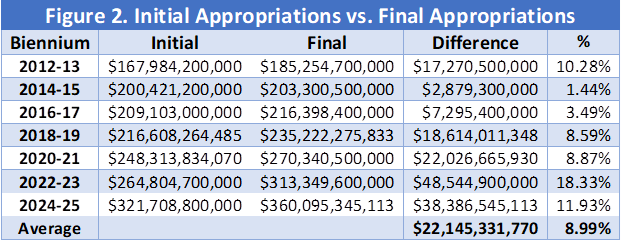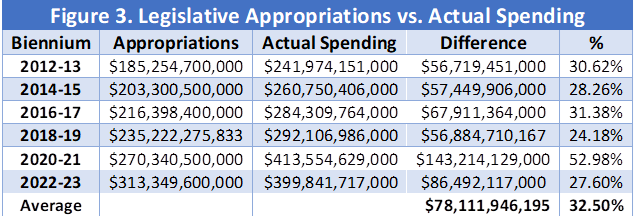State-Controlled 2026-27 Spending in Texas Likely to Top $600 Billion
Reason #5 Why Republicans Should Vote Against the Texas Budget
This is the fifth installment of the series, Ten Reasons Why Republicans Should Vote Against the Texas Budget, originally written and published by Texans for Fiscal Responsibility.
The Texas budget is put together using smoke and mirrors. Everything about the appropriations process is designed to hide the total cost and true size of the state government from Texas taxpayers.
For instance, the Legislative Budget Board shows that total Texas state all-funds spending for the 2026-27 biennium will be $337.4 billion. However, three adjustments based on calculations using historical trends suggest that final state-controlled spending for the biennium will instead be closer to $608 billion.
Initial Appropriations vs. Final Appropriations
Every session the Texas Legislature passes an appropriations bill. And every session the Texas Legislative Budget Board reports how much money is appropriated in the bill for the upcoming fiscal biennium. Then two years later the next session rolls around and the LBB reports that the appropriation for that biennium is actually more than was appropriated in the previous session. The difference since 2012 has been 8.99%.
Final Appropriations vs. Actual Spending
Texas Comptroller Glenn Hegar recently reported that the state of Texas spent $212 billion in FY 2024, an increase of 6.6% over the previous year. The comptroller’s number is far higher than the number from the Legislative Budget Board, which shows spending is closer to $172 billion for the year. The reason for this is that tens of billions of dollars of state spending every biennium are not included in the LBB’s numbers. Since 2012, the actual spending for the state has exceeded the LBB’s numbers on average by 32.5%, about $78 billion per biennium.
State Education Spending vs. Total Education Spending
The largest spending item in the Texas budget is public education, projected to cost about $101 billion in the 2026-27 biennium. But that amount does not tell the complete story. Total spending on government schools and the education bureaucracy is much higher when including state and state-controlled local spending. While not all property tax revenue flows through the state, it is accounted for in the state education funding formulas. Additionally, the state controls how much property tax revenue school districts can raise (although they do a poor job of it). Schools get to set their own budgets, but the state of Texas controls the total amount of education spending. On average, since 2012, the difference between state and total education spending is 119% per biennium, or about $78 billion.
Conclusion
After making these adjustments, the total projected state-controlled spending for 2026-27 is $607.7 billion, an average of almost $304 billion annually, 80% more than the Legislature’s official budget documents. Texans deserve more accurate budget reports. And a smaller government.
A more detailed explanation of these adjustments may be found here.










Thank you for the work you do. The IRS reports there were 23,242,098 taxpayers in Texas in 2023 (latest available figures).
That means that annually, the state is squandering $13,074 from the earnings of every Texas taxpayer. Most of us can think of many things we can better do with our own money rather than government programs that line the pockets of special interests and serve Texans poorly.